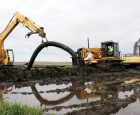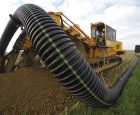
Features
Drainage Management Systems
Pipe dreams
How advancements to drain tile have influenced the drainage industry.
May 2, 2018 By Jannen Belbeck
 Clay tile did the trick With the advent of GPS technology and the development of the newest tile plows
Clay tile did the trick With the advent of GPS technology and the development of the newest tile plowsWith the advent of GPS technology and the development of the newest tile plows, it can be easy to forget about how far the tile industry has come in terms of technology and advancements.
From the beginnings of clay and concrete tile, to the manufacturing of corrugated wall high-density polyethylene (HDPE) pipe in the 1960s, drainage pipe has continued to advance, offering easier installation, a safer worksite, and cost-savings like less labor and time spent in the field.
Advent of HDPE
Clay drainage tile was typically four inches in diameter, installed in one-foot sections laid end to end and buried about three feet deep. While the clay or concrete tile did its job, the installation was labor intensive and required a large crew. Today, customers and contractors would be hard-pressed to find a crew or manufacturer still working with those materials in the realm of agricultural drainage.
High-density polyethylene was discovered in 1951 and first used to make baby bottles. In the 1960s, the owners of Advanced Drainage Systems (ADS), Marty Sixt and Ron Martin, were some of the first to manufacture tiles from the material in long, continuous lengths. Agriculture was one of the first industries that saw its use.
The first commercially manufactured corrugated HDPE drainage pipes were four inches in diameter (the same as what was manufactured for clay/concrete), before they got larger, moving from four, to six, to eight and in the mid-1970s, some companies began making 12-inch pipe. Twenty years after the first HDPE pipe was manufactured, the ’80s saw the first dual-wall (or double wall) pipe sold.
Instead of water flowing through the uneven surface of corrugation of a single wall pipe, dual-wall pipe (DWP) allowed for faster water flow efficiency – a much-needed feature for large rain events at critical times in a crop’s growing cycle.
Manufacturing dual-wall pipe involves a different extrusion process than typical single wall pipe. Today, DWP is manufactured a bit differently than it was in the ’80s – and with better quality, thanks to technological advancements in plastics formulation and manufacturing processes.
“The way it is produced today by the industry was a mid-90s revolution or change in process,” says Jamie Duininck, co-owner of Prinsco.
He says likely by the early 2000s (or maybe even the late ’90s), most – if not all – pipe companies were manufacturing dual-wall more or less the same way, with similar size options.
Aaron Kassing, vice-president of marketing for Timewell Drainage Products, calls the creation of plastic tile “one of the greatest things that happened to the tiling industry.”
“[Plastic] made it so much easier when we were able to move away from the high labor that was needed to install the clay. I would call the development of dual-wall and flexible dual-wall pipe as enhancements to the industry,” he says. “That is to say that dual wall and max flex dual wall didn’t replace single-wall pipe, but they created a better product for specific applications.”
Flexible dual-wall
The last couple of years have seen the release of flexible dual-wall (FDW) HDPE pipe in North America. A product ideal for areas with a high water table, FDW is manufactured to be as flexible as possible, but with enough strength to avoid crushing.
Primarily used for the collector lines, FDW continues to save contractors on labor cost and time spent in the field. For example, data from Prinsco highlights 60 percent faster installation with their version of flexible dual-wall. FDW in general also improves worker safety. When flexible dual-wall products were introduced into the marketplace, it helped with the installation of the mains.
“From a speed standpoint, there are very significant speed increases [with FDW] and from a safety standpoint, there’s no one in the trench box,” Duininck says.
Because of the flexibility needed for the FDW to be coiled into a maxi and run through a boot and installed, the inner wall isn’t as smooth as standard dual-wall pipe, Kassing says, and the flow rate is slightly affected. But Kassing says it’s still very similar – after all, flexible dual-wall may be a slight bit more expensive, but the labor costs and time spent in the field lead to the installation of the main line cheaper for the contractor (and, in turn, the customer).
In order to use this newest pipe technology, FDW often has to be installed with modified equipment, but Kassing says none of his customers have experienced issues with this.
For the future
Research and development in a variety of industries will continue to change how drainage contractors operate – and even what their jobs encompass. It’s not unusual to see contractors doing other excavation jobs, and installing saturated buffers and constructed wetlands to mitigate the environmental effects of nutrient run-off, all in addition to their regular drainage work.
The tile industry may also see advancements in an environmentally friendly manner. For example, recent research from Villanova University found the performance of HDPE pipe made from virgin material was indistinguishable from pipe containing recycled HDPE resin. Pipe manufacturers aligning with drainage sustainability make sense – the majority of the research focus is on sustainability. For example, scientists with Agriculture and Agri-Food Canada presented a study at the International Drainage Symposium in 2016, showing there are optimal combinations of tile depth and spacing to reduce nutrient losses (both surface and subsurface). And, in one of the many research projects by the Illinois Drainage Research and Outreach Program (I-DROP), the team is evaluating dissolved phosphorus in tile drainage to develop a new drain concentration table to answer questions about how and why phosphorus is transported through subsurface drainage.
Drainage research allows contractors to be up to date with best practices, and in turn continue to educate the farmer (and the public) that drainage does more than improve crops yields.
Echoing the directions and considerations of the research, Kassing believes environmentally conscious drainage systems are the future.
“I think we will continue to see a push from the industry, as well as partnering farmers, to look at new and innovative ways they can retain some subsurface moisture and monitor some of the outflows,” he says. “Constructed wetlands, things of that nature will continue to be a growing area in our industry.”
Drain tile and the manufacturers will likely have a role to play.
Print this page

